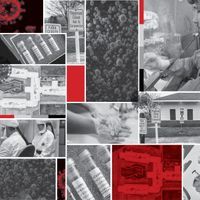Login
Subscribe404
Not Found
Is this what you were looking for?
tag lost colony genetics genomics microbiology

Lost Colonies
Anna Azvolinsky | Oct 1, 2015 | 10+ min read
Next-generation sequencing has identified scores of new microorganisms, but getting even abundant bacterial species to grow in the lab has proven challenging.

Genome Spotlight: Nile Rat (Avicanthis niloticus)
Christie Wilcox, PhD | Nov 23, 2022 | 4 min read
A reference sequence for this emerging model organism will facilitate research on type 2 diabetes and the health effects of circadian rhythm disruption.

How Bacterial Communities Divvy up Duties
Holly Barker, PhD | Jun 1, 2023 | 10+ min read
Biofilms are home to millions of microbes, but disrupting their interactions could produce more effective antibiotics.

A Pioneer of The Multiplex Frontier
Rashmi Shivni, Drug Discovery News | May 20, 2023 | 10 min read
George Church is at it again, this time using multiplex gene editing to create virus-proof cells, improve organ transplant success, and protect elephants.

Those We Lost in 2019
Ashley Yeager | Dec 30, 2019 | 6 min read
The scientific community said goodbye to Sydney Brenner, Paul Greengard, Patricia Bath, and a number of other leading researchers this year.

Symbiotic Organs: Extreme Intimacy with the Microbial World
Catherine Offord | Oct 3, 2022 | 10+ min read
All multicellular creatures interact with bacteria, but some have taken the relationship to another level with highly specialized structures that house, feed, and exploit the tiny organisms.

What’s the Deal with Bacterial Nanotubes?
Sruthi S. Balakrishnan | Jun 1, 2021 | 10+ min read
Several labs have reported the formation of bacterial nanotubes under different, often contrasting conditions. What are these structures and why are they so hard to reproduce?

Follow the Coronavirus Outbreak
The Scientist | Feb 20, 2020 | 10+ min read
Saliva tests screen staff and students at University of Illinois; Study ranks species most susceptible to SARS-CoV-2 infection; COVID-19 clinical trials test drugs that inhibit kinin system

Monitoring Mutations with Microfluidics
Ruth Williams | Mar 15, 2018 | 3 min read
A device dubbed the “mother machine” enables real-time observation of mutagenesis in single bacterial cells.
How Bacteria Talk
Karen Hopkin | Jun 1, 2006 | 6 min read
It's a good thing "rock star of microbiology" Bonnie Bassler didn't end up studying cancer